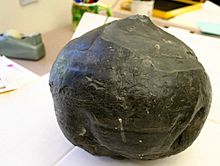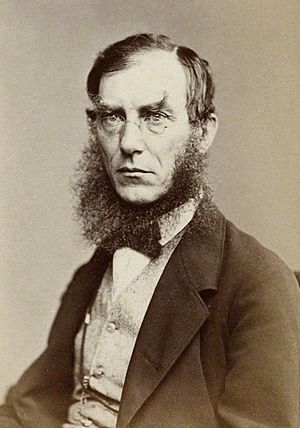Coal ball facts for kids

A coal ball
|
|
| Composition | |
|---|---|
| Permineralised plant remains |
A coal ball is a special kind of rock that looks a bit like a ball or a flat slab. It formed a very long time ago, during the Carboniferous Period, in ancient swamps and wet areas. Even though it's called a coal ball, it's actually not made of coal at all!
Instead of turning into coal, the plant material inside a coal ball turned into stone. This happened because a lot of a mineral called calcite surrounded the peat (partly decayed plant matter). This calcite stopped the peat from becoming coal and instead turned it into a hard, stony fossil.
Coal balls are super important to scientists. They often hold amazing details of tiny plant parts from the Carboniferous swamps. These details would usually be lost, but in coal balls, they are perfectly preserved. Scientists can cut and peel these coal balls to study ancient plants and learn about Earth's past.
Contents
Where Are Coal Balls Found?
Coal balls can be found inside coal layers in places like North America and Eurasia. They are more common and spread out in North America than in Europe. The oldest known coal balls are from a time called the Namurian stage of the Carboniferous Period. These old ones were found in Germany and what used to be Czechoslovakia.
Inside a coal layer, coal balls are completely surrounded by coal. They might be scattered randomly in small groups, often in the upper part of the coal layer. Sometimes, a coal layer has no coal balls at all. Other times, there are so many that miners have to avoid those areas.
Who Discovered Coal Balls?
The first scientific description of coal balls was made in England in 1855. Two English scientists, Joseph Dalton Hooker and Edward William Binney, were the first to report on them. Early research on coal balls mostly happened in Europe.
Later, in 1922, coal balls were found and identified in North America. Since then, they have been discovered in many other countries. This has led to the discovery of hundreds of new species and genera (groups) of ancient plants.
Other scientists also studied coal balls. Marie Stopes and D.M.S. Watson believed that coal balls formed right where the plants grew. They also thought that contact with the sea was needed for a coal ball to form. In 1962, Sergius Mamay and Ellis Yochelson even found signs of ancient sea animals inside North American coal balls.
How Well Are They Preserved?
The quality of how well the plant material is preserved depends on a few things. It matters how quickly the plants were buried and how much they were squashed before they turned into stone. Generally, if plants were buried fast with little decay or pressure, their details are preserved better. However, many coal balls still show some signs that the plants decayed or collapsed a bit before becoming stone.
Related pages
Images for kids
-
Calcite (middle) and dolomite (top and bottom) are common materials found in coal balls.
See also
 In Spanish: Bola de carbón para niños
In Spanish: Bola de carbón para niños





